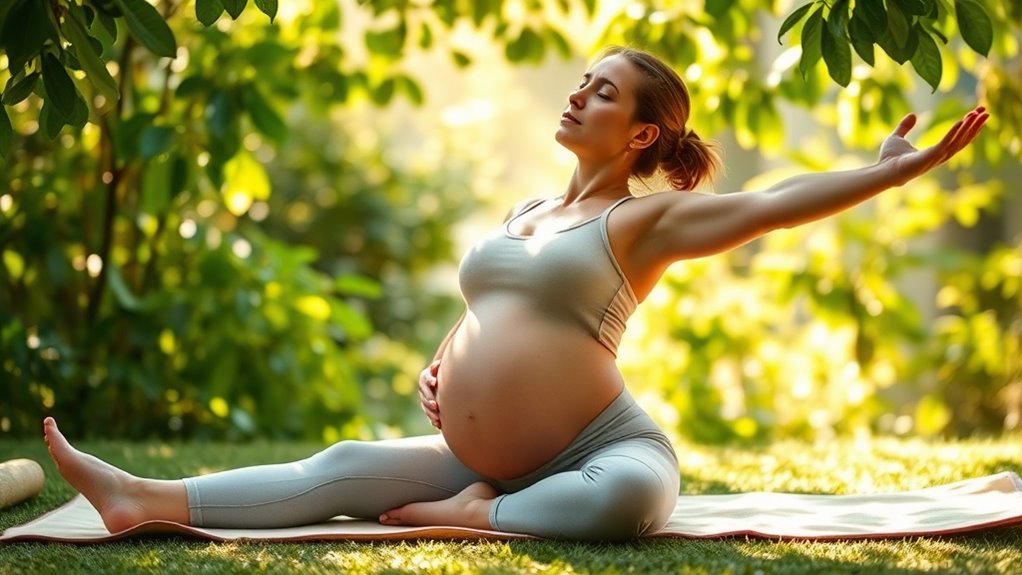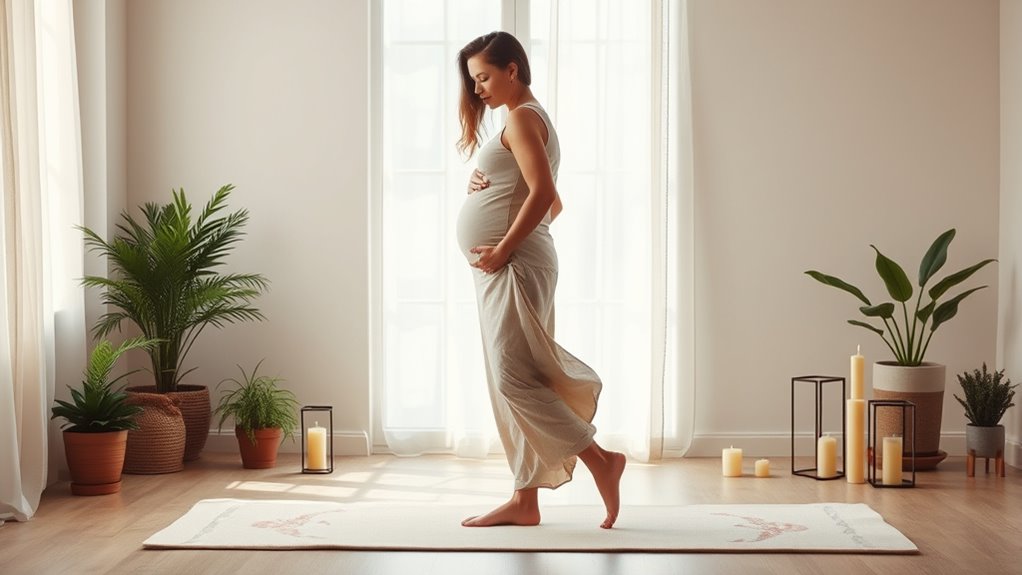If you’re a pregnant mom looking to support your body and mind, try incorporating gentle poses into your routine. Child’s Pose is perfect for relaxation while Ankle to Knee helps open the hips. Listen to your body and modify poses as needed, using props for extra support. Practicing deep breathing can also help ease stress. There are plenty of other poses tailored for your journey, so keep exploring to discover what works best for you.
Key Takeaways
- Child’s Pose promotes relaxation and helps relieve tension in the back, making it ideal for pregnant moms.
- Ankle to Knee pose opens the hips and enhances flexibility, providing comfort during pregnancy.
- Knees Together Feet Apart helps prepare the pelvis for childbirth, promoting optimal positioning.
- Incorporating props like blocks and bolsters supports safe modifications of poses for comfort.
- Deep breathing techniques during yoga can effectively manage stress and anxiety throughout pregnancy.

When you’re pregnant, practicing yoga can be a wonderful way to connect with your body and prepare for labor. It offers a range of benefits that can enhance your physical and emotional well-being during this transformative time.
However, it’s crucial to keep safety considerations in mind. Always get medical clearance from your healthcare provider before you begin any prenatal yoga practice. This ensures that you’re engaging in exercises that are safe for both you and your baby. Recent studies have indicated that no safety issues were reported when practicing certain poses during pregnancy, providing reassurance for expectant mothers.
As your body changes, many traditional yoga poses can be modified for safety and comfort. Using props like blocks and bolsters can help you maintain balance and support your growing belly. It’s essential to listen to your body throughout your practice. If you feel any discomfort or pain, stop immediately. The hormone relaxin increases your flexibility, but it’s important to avoid overstretching to prevent injury.
Prenatal yoga can significantly reduce stress and anxiety, thanks to its focus on deep breathing techniques. These practices help calm your mind, allowing you to enjoy your pregnancy more fully.
In addition to mental health benefits, yoga improves circulation, aids digestion, and helps maintain muscle tone, which is crucial as your body adapts to the changes occurring during pregnancy. You might also find relief from common discomforts like lower back pain, nausea, and headaches.
In your first trimester, gentle poses like Child’s Pose can provide comfort and relaxation. Focus on hip-opening poses such as Ankle to Knee to enhance flexibility. If you’re feeling nauseous, practice only when you’re comfortable, and take breaks as needed.
As you transition into the second trimester, continue making modifications to accommodate your growing belly. Avoid deep abdominal contractions and emphasize balance, using props to help with poses like Warrior II.
By the third trimester, you’ll want to prepare your body for labor. Poses like Knees Together Feet Apart can help open your pelvis and promote optimal positioning for childbirth. Restorative yoga becomes increasingly beneficial, alleviating swelling and discomfort.
Focus on using blocks and blankets for support in your restorative poses, and practice your breathing techniques to manage labor pain.
Frequently Asked Questions
Is It Safe to Practice Yoga During All Stages of Pregnancy?
Yes, it’s generally safe to practice yoga during all stages of pregnancy, as long as you modify poses and listen to your body.
Many women find that yoga helps with physical discomfort and mental well-being.
Just remember to avoid heated classes and inversions, and consult your healthcare provider before starting.
Pay attention to how you feel, and make adjustments as needed to ensure a safe and enjoyable practice throughout your pregnancy.
What Modifications Should I Make for Different Trimesters?
When practicing yoga during pregnancy, you should make specific modifications for each trimester.
In the first trimester, avoid deep twists and backbends.
During the second trimester, use props for support and avoid lying flat on your back.
In the third trimester, focus on restorative poses and gentle hip openers.
Always listen to your body, modify poses for comfort, and remember to breathe deeply without retention.
Prioritizing safety will enhance your practice.
Can Yoga Help With Pregnancy-Related Discomforts?
Absolutely, yoga can help with pregnancy-related discomforts.
You’ll find gentle stretches and mindful breathing techniques alleviate back pain and improve circulation. As you practice, you’ll notice enhanced digestion and better posture, reducing strain on your body.
Additionally, yoga promotes relaxation, helping to ease stress and anxiety. This holistic approach not only addresses physical challenges but also boosts your emotional well-being, making your pregnancy journey smoother and more enjoyable.
Are There Any Specific Poses to Avoid While Pregnant?
Yes, there are specific poses you should avoid while pregnant.
Inversions like headstands and handstands can increase your risk of falling, while poses that compress the abdomen, like plow and full wheel, can strain your body.
Closed twists may stress your baby and compress the uterus.
It’s best to steer clear of forward folds and poses that put pressure on your abdomen after the first trimester.
Always listen to your body and consult a professional.
How Often Should I Practice Yoga During Pregnancy?
You might find yourself wondering how often you should practice yoga during pregnancy, especially as your body changes.
Experts suggest aiming for at least 30 minutes of activity each day, with yoga sessions lasting anywhere from 20 to 120 minutes.
Listen to your body and adjust your frequency based on what feels best.
Whether it’s daily or a few times a week, consistency will help you maintain balance, alleviate stress, and support your overall well-being.
Conclusion
As you embrace these yoga moves, think of yourself as a tree, roots firmly planted and branches gently swaying. Just like a tree adapts to the changing seasons, you’re nurturing your body and your baby, finding strength and flexibility in each pose. Studies show that prenatal yoga can reduce stress and improve sleep, helping you feel more connected to your little one. So, breathe deeply, stretch with intention, and let your inner strength flourish as you prepare for motherhood.









